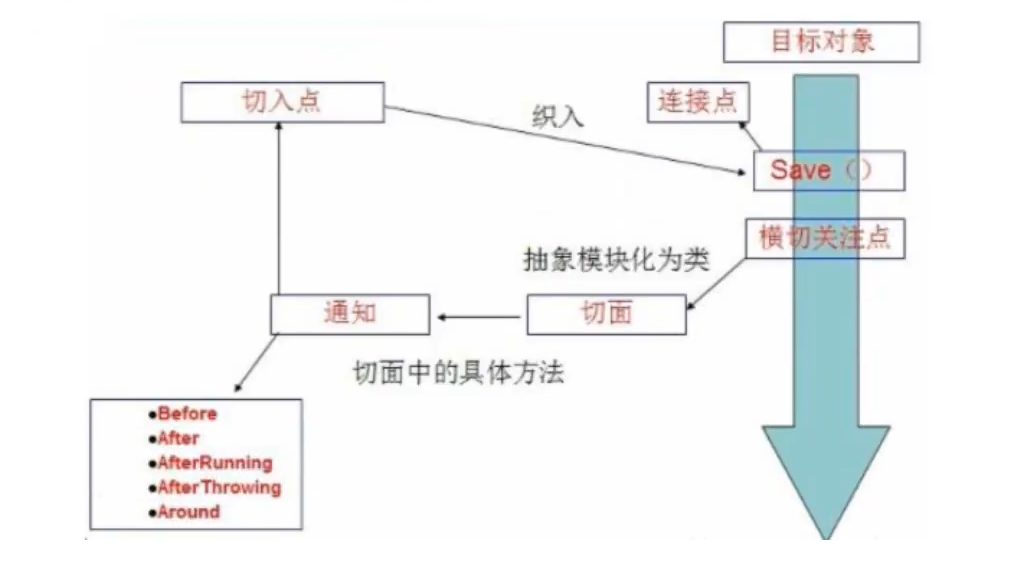1. AOP(面向切面编程)
1.1 什么是AOP
具体的可以查看官方文档
AOP(Aspect Oriented Programming)意为:面向切面编程,通过预编译方式和运行期动态代理实现程序功能的统一维护的一种技术。AOP是OOP的延续,是软件开发中的一个热点,也是Spring框架中的一个重要内容,是函数式编程的一种衍生范型。利用AOP可以对业务逻辑的各个部分进行隔离,从而使得业务逻辑各部分之间的耦合度降低,提高程序的可重用性,同时提高了开发的效率。
1.2 AOP在Spring中的应用
- 横切关注点:跨越应用程序多个模块的方法或功能。即是,与我们业务逻辑无关的,但是我们需要关注的部分,就是横切关注点。如日志 , 安全 , 缓存 , 事务等等 ….
- 切面(ASPECT):横切关注点 被模块化 的特殊对象。即,它是一个类。
- 通知(Advice):切面必须要完成的工作。即,它是类中的一个方法。
- 目标(Target):被通知对象。
- 代理(Proxy):向目标对象应用通知之后创建的对象。
- 切入点(PointCut):切面通知 执行的 “地点”的定义。
- 连接点(JointPoint):与切入点匹配的执行点。
AOP实践的前期准备
导入依赖
使用AOP织入,需要导入一个依赖包
<dependencies><dependency><groupId>org.aspectj</groupId><artifactId>aspectjweaver</artifactId><version>1.9.4</version></dependency></dependencies>
业务接口和实现类
public interface UserService {void add();void delete();void update();void query();}
public class UserServiceImpl implements UserService {@Overridepublic void add() {System.out.println("增加用户");}@Overridepublic void delete() {System.out.println("删除用户");}@Overridepublic void update() {System.out.println("更改用户信息");}@Overridepublic void query() {System.out.println("查询用户");}}
二、AOP实现
方式一:实现原生的Spring API接口
- 编写实现Spring API原生接口的类(例如Log类) ```java package com.comprehensive.log;
import org.springframework.aop.MethodBeforeAdvice;
import java.lang.reflect.Method;
public class BeforeLog implements MethodBeforeAdvice { @Override public void before(Method method, Object[] args, Object target) throws Throwable { System.out.println(target.getClass().getName() + “的” + method.getName() + “被调用了”); } }
```javapackage com.comprehensive.log;import org.springframework.aop.AfterReturningAdvice;import java.lang.reflect.Method;public class AfterLog implements AfterReturningAdvice {@Overridepublic void afterReturning(Object returnValue, Method method, Object[] args, Object target) throws Throwable {System.out.println(target.getClass().getName() + "的" + method.getName() + "被调用了,返回值为" + returnValue);}}
在Spring的配置文件中注册 , 并实现aop切入实现 , 注意导入约束 ```xml <?xml version=”1.0” encoding=”UTF-8”?>
<aop:pointcut id="pointCut1" expression="execution(* com.comprehensive.service.UserService.*(..))"/> <aop:advisor advice-ref="beforeLog" pointcut-ref="pointCut1"/> <aop:advisor advice-ref="afterLog" pointcut-ref="pointCut1"/>
- 编写测试类进行测试
```java
package com.comprehensive.service;
import org.junit.Test;
import org.springframework.context.ApplicationContext;
import org.springframework.context.support.ClassPathXmlApplicationContext;
public class UserServiceTest {
@Test
public void test1() {
ApplicationContext context = new ClassPathXmlApplicationContext("beans1.xml");
UserService userService = context.getBean("userServiceImpl", UserService.class);
userService.add();
}
}
方式二:自定义类实现AOP
- 编写自己的一个切入类 ```java package com.comprehensive.aop;
public class DIY_AOPService { public void before() { System.out.println(“————-方法执行前————-“); } public void after() { System.out.println(“————-方法执行后————-“); } }
- Spring的配置文件中进行注册
```xml
<?xml version="1.0" encoding="UTF-8"?>
<beans xmlns="http://www.springframework.org/schema/beans"
xmlns:xsi="http://www.w3.org/2001/XMLSchema-instance"
xmlns:aop="http://www.springframework.org/schema/aop"
xsi:schemaLocation="http://www.springframework.org/schema/beans
http://www.springframework.org/schema/beans/spring-beans.xsd
http://www.springframework.org/schema/aop
http://www.springframework.org/schema/aop/spring-aop.xsd">
<bean id="userServiceImpl" class="com.comprehensive.service.UserServiceImpl"/>
<bean id="aopService" class="com.comprehensive.aop.DIY_AOPService"/>
<aop:config>
<aop:pointcut id="pointCut1" expression="execution(* com.comprehensive.service.UserService.*(..))"/>
<aop:aspect ref="aopService">
<aop:before pointcut-ref="pointCut1" method="before"/>
<aop:after pointcut-ref="pointCut1" method="after"/>
</aop:aspect>
</aop:config>
</beans>
- 编写测试类进行测试 ```java package com.comprehensive.service;
import org.junit.Test; import org.springframework.context.ApplicationContext; import org.springframework.context.support.ClassPathXmlApplicationContext;
public class UserServiceTest { @Test public void test2() { ApplicationContext context = new ClassPathXmlApplicationContext(“beans2.xml”); UserService userService = context.getBean(“userServiceImpl”, UserService.class); userService.delete(); } }

<a name="FROch"></a>
### 方式三:使用注解实现AOP
- 编写自己的一个切入类,然后使用注解进行配置
```java
package com.comprehensive.aop;
import org.aspectj.lang.annotation.After;
import org.aspectj.lang.annotation.Aspect;
import org.aspectj.lang.annotation.Before;
@Aspect
public class Annotation_AOPService {
@Before("execution(* com.comprehensive.service.UserService.*(..))")
public void before() {
System.out.println("====执行前====");
}
@After("execution(* com.comprehensive.service.UserService.*(..))")
public void after() {
System.out.println("====执行后====");
}
}
Spring配置文件中进行注册,并增加支持注解的配置 ```xml <?xml version=”1.0” encoding=”UTF-8”?>
- 编写测试类进行测试
```java
package com.comprehensive.service;
import org.junit.Test;
import org.springframework.context.ApplicationContext;
import org.springframework.context.support.ClassPathXmlApplicationContext;
public class UserServiceTest {
@Test
public void test3() {
ApplicationContext context = new ClassPathXmlApplicationContext("beans3.xml");
UserService userService = context.getBean("userServiceImpl", UserService.class);
userService.update();
}
}




